You'll discover unmatched freshness and vibrancy when creating citrus perfumes from essential oils, particularly through cold-pressed extraction. These natural oils capture the bright, authentic essence of fruits like bergamot, lemon, and orange while retaining beneficial compounds that synthetic alternatives lack. Your custom blends can uplift mood, reduce stress, and create unique signature scents. By mastering citrus perfumery, you'll reveal an ancient art that connects aromatherapy with sophisticated fragrance design.
The Magic of Cold-Pressed Citrus Oils
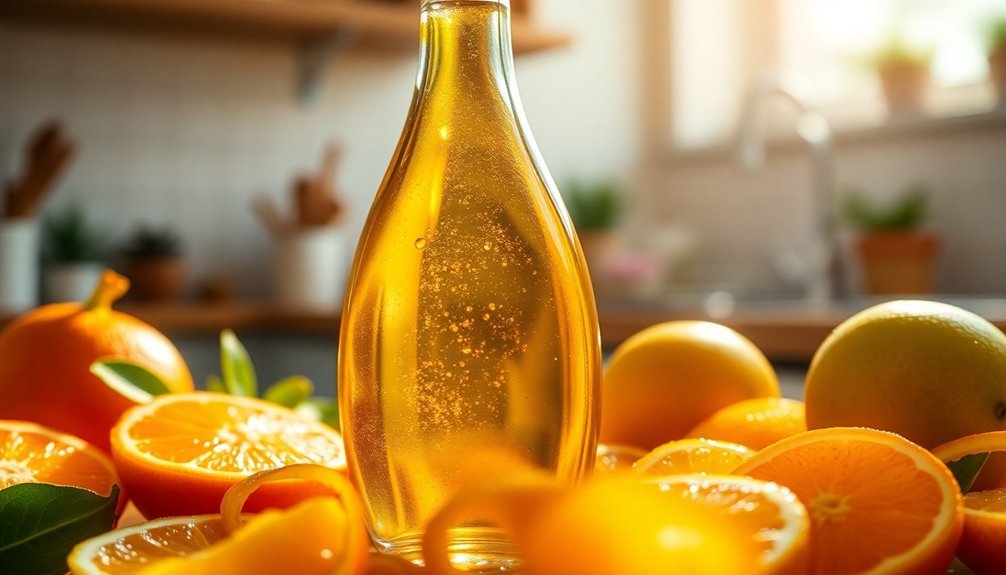
While many perfume ingredients rely on complex extraction methods, cold-pressed citrus oils stand out for their simplicity and authenticity. The process involves grinding citrus peels to release essential oils from their tiny glands, preserving the fruit's natural aroma without using high temperatures. These citrus essential oils can be stored and bottled after extraction to maintain their quality and potency.
You'll find these cold-pressed oils capture the bright, fresh essence of their source fruits perfectly. Orange and lemon oils deliver vibrant citrus scents, while bergamot offers complex floral undertones.
What's remarkable is that this gentle extraction method retains more beneficial compounds, including vitamins and antioxidants.
When you're working with these oils, remember they're highly concentrated and often phototoxic. While they're fantastic for perfumery, you'll need to be cautious about sun exposure if you're applying them to your skin.
Some bergamot varieties come with the phototoxic component removed for safer use.
Essential Properties of Top Notes in Perfumery
When you first apply a citrus perfume, the top notes burst forth with an energetic freshness that creates your fragrance's essential first impression.
These bright, volatile notes radiate outward, projecting the scent into your surroundings while setting the stage for the heart notes that will emerge. Common citrus oils like Lemon and Bergamot provide this initial aromatic impact.
You'll find that successful citrus perfumes carefully balance their zesty top notes with middle accords, ensuring a smooth shift as the fragrance evolves on your skin.
Immediate Impact Upon Application
Have you ever noticed how certain fragrances make an immediate impression the moment they touch your skin? When you apply a citrus-based perfume, you're experiencing the power of top notes, which last about 5-15 minutes and set the tone for your entire fragrance experience.
Citrus elements like bergamot, lemon, and grapefruit create that initial burst of freshness you'll notice right away. These aren't just pleasant scents – they're working on your brain's limbic system to boost your mood and reduce stress. The rich tradition of citrus in perfumery dates back to when Queen of Hungary water first introduced these dynamic notes in 1370.
You'll find that citrus top notes can improve your performance and energy levels, whether you're facing a challenging day or just need a pick-me-up. The volatile nature of these oils means they'll quickly make way for deeper notes, but their immediate impact can transform your mood and set a positive tone for hours.
Scent Diffusion And Range
The remarkable properties of citrus top notes shine through their unique diffusion characteristics. You'll notice their quick evaporation within 5-15 minutes, creating an immediate, invigorating impact that sets the stage for deeper fragrance layers.
When using citrus oils in your diffuser, you'll need to adjust the amount based on your space. Small rooms work well with 3-5 drops, while larger areas require 7-10 drops for ideal coverage.
Your choice of diffuser matters too – nebulizing types excel with citrus oils, breaking them into fine particles for wider dispersion without dilution.
You'll find these oils particularly effective in creating an uplifting atmosphere, as they work through the limbic system to reduce anxiety and boost mood.
Their fresh, airy quality makes them perfect for establishing an inviting ambiance in any space.
Balancing With Heart Notes
Selecting the right heart notes creates an essential bridge between fleeting citrus top notes and lasting base notes in your perfume composition.
You'll find that floral notes like rose and jasmine add depth while extending your fragrance's longevity, while geranium offers a versatile connection point that enhances the overall wear time.
When balancing citrus with heart notes, focus on these key aspects:
- Choose heart notes that complement rather than overpower your citrus top notes.
- Consider the psychological impact – certain combinations can boost mood and reduce stress.
- Aim for a smooth shift that maintains the fragrance's presence after the initial citrus burst fades.
Your heart note selection will determine how well your perfume evolves on the skin, creating a complex and engaging sensory experience that captivates throughout the day.
Understanding Limonene and Its Role
Among fragrance molecules found in citrus perfumes, limonene stands out as an essential cyclic monoterpene that gives citrus fruits their characteristic fresh scent.
You'll find this colorless liquid mainly in citrus peels, where it's extracted through steam distillation or centrifugal separation.
When you're working with limonene in perfumery, you'll notice it exists in two forms: d-limonene and l-limonene.
The commercial d-limonene you'll use typically has 90-98% purity, with other monoterpenes making up the remaining content.
While it's excellent for creating uplifting, fresh fragrances, you'll need to dilute it properly before skin application to avoid irritation.
Beyond its aromatic properties, limonene offers antimicrobial benefits and mood-enhancing effects, making it a valuable component in your citrus perfume formulations.
Blending Ratios for Citrus-Based Accords
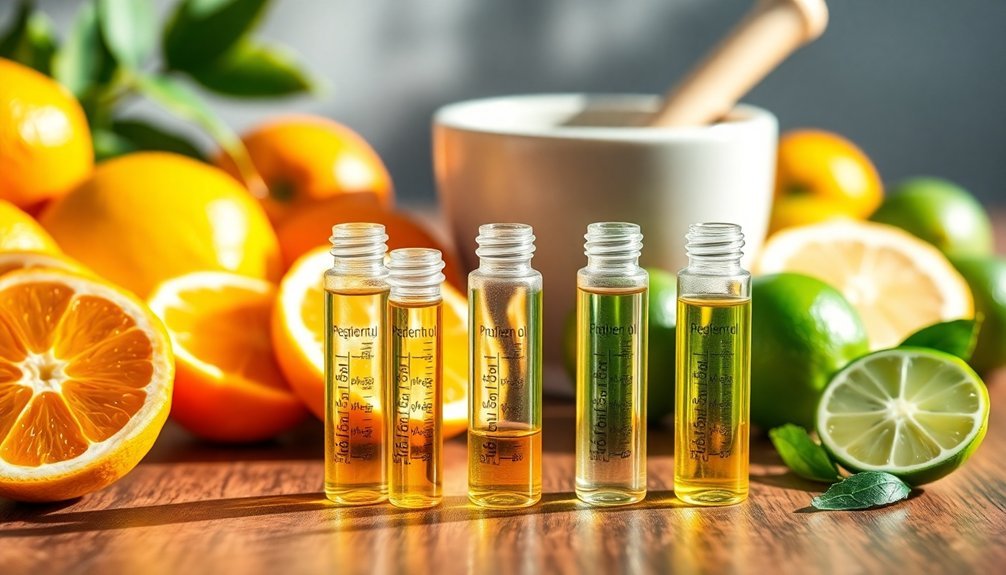
Creating effective citrus-based accords requires understanding fundamental blending ratios, which typically follow a 3:2:1 or 4:2:1 pattern for top, middle, and base notes.
When working with citrus oils, you'll need to adjust these ratios carefully since they're potent top notes that can easily overwhelm your blend.
For successful citrus perfume creation, follow these essential steps:
- Start with a 20% fragrance concentration (20 drops of essential oils per 100 drops total)
- Blend citrus with patchouli using a 3:1 or 4:1 ratio
- Record each drop added to maintain consistency and enable future adjustments
You'll want to use carrier oils like jojoba or sweet almond to dilute your blend properly.
Remember that grapefruit needs a higher ratio than lemon or orange due to its milder nature, so adjust accordingly.
Safety Guidelines for Phototoxic Oils
While mastering citrus blend ratios is important, understanding phototoxicity can make or break your perfume's safety profile.
If you're using cold-pressed citrus oils like bergamot, lemon, lime, or grapefruit, you'll need to follow strict dilution guidelines to prevent skin reactions from UV exposure.
You'll want to limit bergamot to 0.4% (1 drop per ounce of carrier oil) and grapefruit to 4% (24 drops per ounce).
Don't combine multiple phototoxic oils at maximum levels, as this increases reaction risks.
Consider using alternatives like steam-distilled versions or FCF (furanocoumarin-free) oils for safer formulations.
If you do use phototoxic oils, include clear instructions for your customers to avoid sun exposure for 12-18 hours after application, or recommend using the perfume on covered skin areas.
Creating Signature Summer Scents
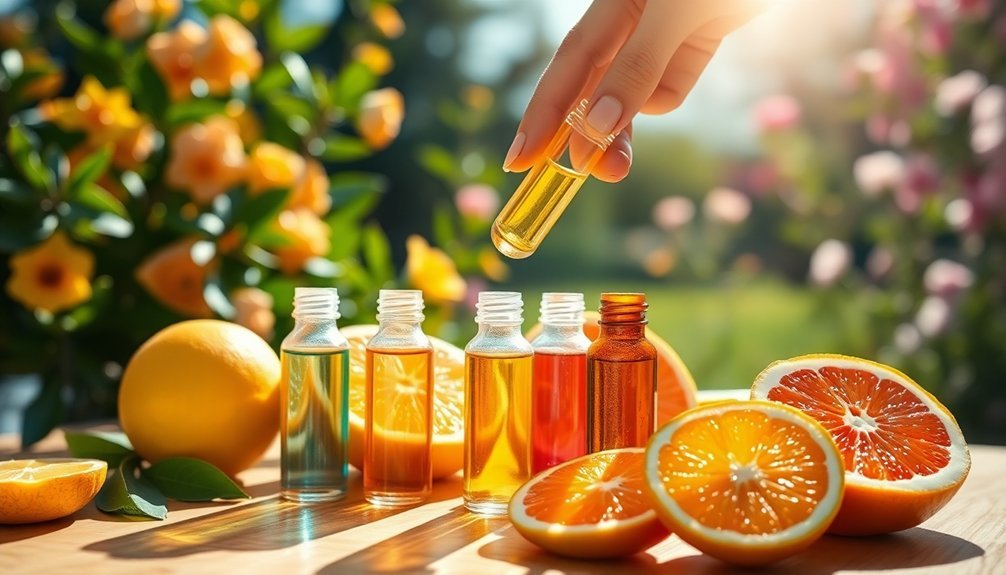
You'll discover that crafting fresh citrus blends starts with selecting bright top notes like grapefruit and lemon, balanced by floral middle notes and grounding base notes.
To achieve seasonal mixing success, combine cooling elements like mint or cucumber with tropical fruits and ocean-inspired aromas that capture summer's essence.
Your signature summer scent should maintain a careful balance between light and warm notes, ensuring the fragrance remains invigorating while having enough depth to last.
Fresh Citrus Blend Basics
As summer temperatures rise, fresh citrus blends offer a perfect way to craft invigorating signature scents that capture the season's vibrant energy.
You'll find these essential oils, derived from fruit rinds, provide cooling and uplifting effects perfect for hot weather wear.
When creating your citrus blend, consider these key approaches:
- Start with a bright top note like lemon or lime for an immediate fresh impact.
- Add depth with sweet orange or grapefruit for a balanced middle.
- Include bergamot to create sophisticated floral undertones.
You can apply your blend in various ways, from diffusing it to creating a personal fragrance.
Just remember to avoid direct sun exposure when wearing citrus oils on skin, as they're naturally phototoxic.
Blend with complementary oils like lavender or peppermint to create complex, unique combinations.
Seasonal Mixing Success Tips
Creating signature summer scents requires a strategic approach to layering and mixing fragrances. You'll want to start with a neutral base of musk, vanilla, or amber to establish a balanced foundation. Then, incorporate fresh citrus notes like bergamot or mandarin to add that essential summer zest. Finally, blend in floral elements such as jasmine or tiaré flower to achieve sophistication and depth.
| Season | Recommended Mix |
|---|---|
| Early Summer | Vanilla + Bergamot + Jasmine |
| Mid-Summer | Amber + Mandarin + Rose |
| Late Summer | Musk + Lemon + Tiaré |
| Indian Summer | Vanilla + Grapefruit + Lavender |
Remember to build your scent gradually, testing the intensity as you go. You'll find that citrus notes work particularly well in warmer months, while the base notes help extend their staying power throughout the day.
Advanced Techniques for Oil Stabilization
While citrus perfumes captivate with their bright, fresh notes, they require sophisticated stabilization techniques to maintain their integrity.
You'll find that alkylphenoxy polyethoxy ethanols are your best allies, especially those with 9-12 moles of ethylene oxide. These stabilizers effectively reduce volatilization and prevent unwanted migration of your fragrance oils.
To maximize your citrus perfume's longevity and performance, focus on these key techniques:
- Mix your fragrance oils with stabilizers before applying them to porous materials like blotting paper.
- Incorporate water-soluble cereal extracts, particularly from oats and maize, to protect against oxidative deterioration.
- Heat-treat your stabilizers above 250°F to enhance their protective properties.
These methods won't just preserve your citrus oils – they'll also help "round out" the scent profile while maintaining the fragrance's intended presence where applied.
Seasonal Variations in Citrus Combinations

You'll find that citrus perfumes adapt beautifully across seasons, from light summer blends featuring bright lime and lemon to cozy winter combinations that pair orange with warm spices.
Spring citrus scents shine when mixed with fresh, aquatic notes that echo spring rain, creating an ethereal atmosphere perfect for the season.
These seasonal variations allow you to maintain the vibrant energy of citrus while perfectly matching the mood and temperature of each time of year.
Summer Fresh Bright Notes
When summer temperatures soar, citrus fragrances offer the perfect aromatic escape with their naturally cooling and invigorating properties.
You'll find that these light, airy scents won't overwhelm your senses, even during the hottest days. Instead, they'll provide a rejuvenating burst that helps uplift your spirit and create a comfortable atmosphere.
For the ultimate summer freshness, consider these bright citrus notes:
- Lemon – delivers a zesty, revitalizing aroma that instantly energizes
- Grapefruit – combines sweet and bitter elements for a uniquely invigorating experience
- Bergamot – adds sophisticated complexity that blends beautifully with other citrus notes
You can wear these versatile scents from day to night, making them perfect for both casual outings and formal evening events.
They'll sit lightly on your skin while maintaining their pleasant, energizing character throughout the day.
Winter Spice Citrus Blends
The alluring combination of citrus and warm spices creates distinctive winter fragrances that transform traditional summer notes into cozy seasonal blends. You'll find a complex interplay of clove, cinnamon, nutmeg, and allspice balanced with sweet orange essential oil, creating an inviting atmosphere perfect for cold winter nights.
| Spice Component | Citrus Element | Aromatic Effect |
|---|---|---|
| Clove & Nutmeg | Sweet Orange | Warm & Spicy |
| Cinnamon | Bergamot | Sweet & Woody |
| Bay & Allspice | Mandarin | Fresh & Complex |
| Vanilla | Blood Orange | Rich & Creamy |
When working with these blends, you'll need to dilute them properly and follow safety precautions, especially regarding skin sensitivity. While they're particularly suited for winter celebrations, you can enjoy these sophisticated combinations year-round, drawing from centuries-old traditions of combining citrus with warming spices.
Spring Rain Citrus Combinations
Spring's delicate balance of rain and sunshine inspires a fresh approach to citrus fragrances, where bright notes mingle with aquatic, floral, and green accords.
You'll find that combining citrus with complementary notes creates sophisticated spring scents that last longer and evolve beautifully on your skin.
Try these spring-inspired citrus combinations:
- Blend orange blossom and neroli with lemon for a floral-citrus perfume that captures blooming gardens.
- Mix grapefruit with fresh herbs like basil or mint for an invigorating unisex fragrance.
- Layer marine notes with citrus to evoke spring showers and ocean breezes.
For lasting power, you can anchor your citrus blend with woody notes like cedar or vetiver.
These combinations work perfectly for both casual weekend outings and formal spring events.
Mastering Classic Citrus Formulations
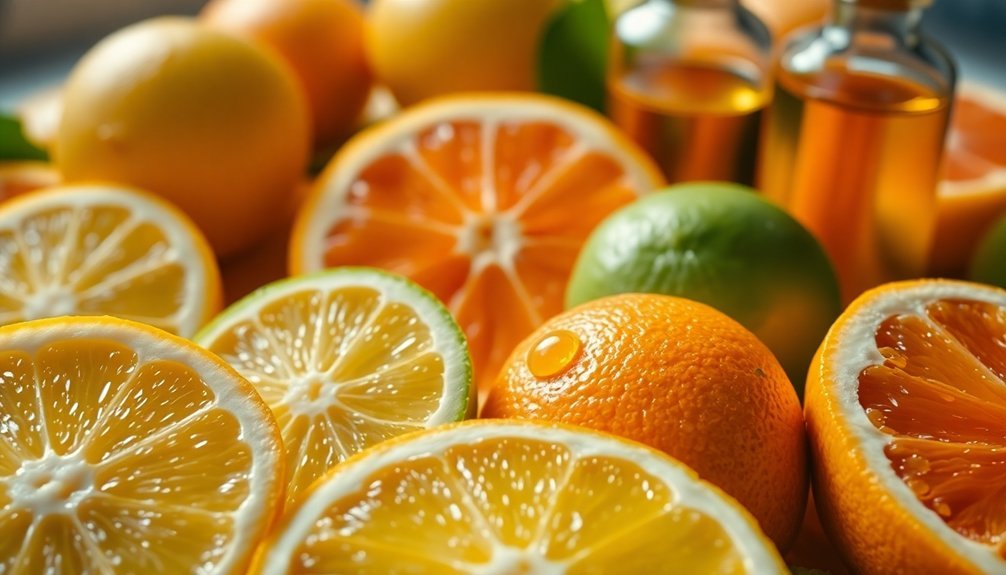
Since ancient Mediterranean cultures first harnessed citrus notes, perfumers have refined these formulations into timeless classics that still captivate us today.
You'll find the art of classic citrus perfumery stems from the pioneering eau de cologne, which masterfully combines lemon, bergamot, petit-grain, and neroli.
To create your own classic formulations, start with bergamot as your foundation – it's versatile enough to bridge both sweet and bitter elements.
You'll want to balance it with sweeter mandarin or orange for warmth, then add depth using grapefruit's complex profile.
For lasting power, blend your citrus oils with earthier base notes like patchouli or vetiver.
The Art of Natural Fixatives
Natural fixatives play an essential role in creating long-lasting citrus perfumes, acting as anchors that slow down the evaporation of volatile essential oils.
You'll find that resinoids like benzoin and labdanum, along with balsams and woods, are particularly effective at stabilizing citrus notes while adding depth to your compositions.
To master natural fixatives in your citrus perfumes:
- Start by macerating labdanum or Peru balsam in alcohol for a month to create a potent fixative base.
- Blend small amounts of sandalwood or patchouli to add longevity without overpowering the bright citrus notes.
- Consider using exalting fixatives like tolu balsam or vanilla to enhance the overall composition while maintaining the citrus character.
These natural ingredients will help equalize vapor pressures and create more stable, longer-lasting fragrances.
Building Complex Citrus Layers

Mastery in building complex citrus layers requires a deep understanding of how different citrus notes interact and evolve together.
You'll want to start with a strong foundation using deeper citrus oils like bergamot as your base note, then build upward with middle notes of lemon or grapefruit, and finish with lighter top notes of lime or mandarin.
Let each layer dry completely before adding the next, and don't overdo it – less is more when you're working with citrus oils.
You can create depth by pairing your citrus notes with complementary scents like woody or floral elements. Start with simple combinations like bergamot and sandalwood, then progress to more intricate blends as you gain confidence.
Keep track of your successful combinations to replicate and refine them later.
Testing and Evaluating Your Creations
Once you've crafted your citrus perfume, proper testing and evaluation become essential to refine your creation. Start by applying your fragrance to high-quality blotters, labeling each one carefully to track different variations.
You'll want to assess how your citrus notes evolve through the fragrance layers, from bright top notes to the deeper base notes.
- Test the perfume on your skin at pulse points, allowing it to dry naturally – citrus oils react uniquely with each person's chemistry.
- Use a scoring system to evaluate your creation objectively, focusing on fragrance quality (30 points), longevity (30 points), and sillage (20 points).
- Take breaks between testing sessions to avoid olfactory fatigue, which can impact your ability to detect subtle nuances in your citrus blend.
Frequently Asked Questions
How Do Different Storage Temperatures Affect the Shelf Life of Citrus Oils?
Your citrus oils will last longest in cold storage at consistent temperatures. They'll degrade quickly in heat or fluctuating conditions. You can expect up to 2 years shelf life when refrigerated, but much less at room temperature.
Can Citrus Oils Be Effectively Used in Solid Perfume Formulations?
Yes, you can effectively use citrus oils in solid perfumes when blended with beeswax and carrier oils. They'll provide fresh, uplifting scents, though you'll need to take into account their volatile nature when determining oil ratios.
Do Citrus Oils From Different Geographical Regions Produce Notably Different Scent Profiles?
Yes, you'll notice distinct scent profiles in citrus oils from different regions. Climate, soil, and agricultural practices influence their volatile compounds, creating unique aromas. You can detect these variations through both analysis and smell.
What Role Does Fruit Ripeness Play in the Quality of Extracted Oils?
You'll get the best essential oils from fully ripened citrus fruits, as they contain peak levels of key monoterpenes. However, you'll notice different compounds dominate at various maturity stages, affecting overall quality.
How Do Synthetic Citrus Oils Compare to Natural Ones in Terms of Performance?
You'll find synthetic citrus oils last longer and maintain consistent scent, while natural ones fade faster. However, natural oils give you more authentic, subtle fragrances without the artificial chemical undertones.
In Summary
You've now explored the fascinating world of citrus perfumery, from selecting cold-pressed oils to mastering complex layering techniques. With your understanding of limonene properties, blending ratios, and natural fixatives, you're ready to create vibrant, long-lasting citrus fragrances. Remember to follow safety guidelines for phototoxic oils and trust your nose as you test and refine your formulations. Your journey into citrus perfumery is just beginning.
References
- https://hiqili.com/blogs/recipes/essential-oils-for-perfume
- http://confcontact.com/2024-suchasni-ntd/conference_materials_suchasni_ntd_in_english_2024.pdf
- https://www.youtube.com/watch?v=6JEEVImZjCU
- https://batch.libretexts.org/print/Letter/Finished/human-170479/Full.pdf
- https://www.hearthandhomesteadstore.com/product-page/silk-road-citrus-natural-perfume-oil
- https://nikura.com/blogs/living-well/a-guide-to-citrus-essential-oils
- https://github.com/tatsu-lab/alpaca_eval/blob/main/results/baize-v2-13b/model_outputs.json
- https://www.aromaweb.com/essentialoils/citrus-essential-oils.php
- https://dl.icdst.org/pdfs/files3/12cc4b715ba1b598c98b5644a197c26c.pdf
- https://essentialthree.com/essential-oil-extraction-method-citrus/

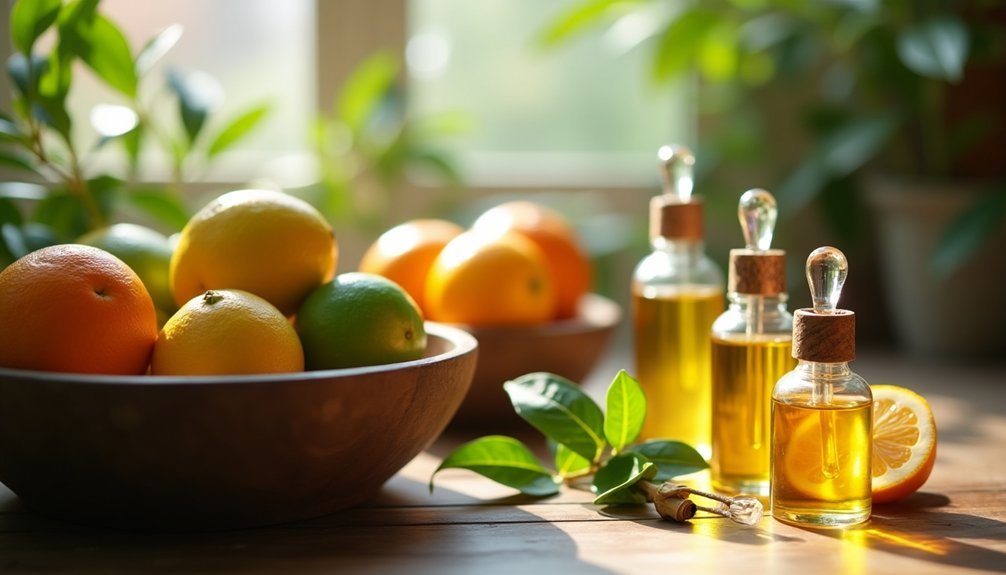



Leave a Reply